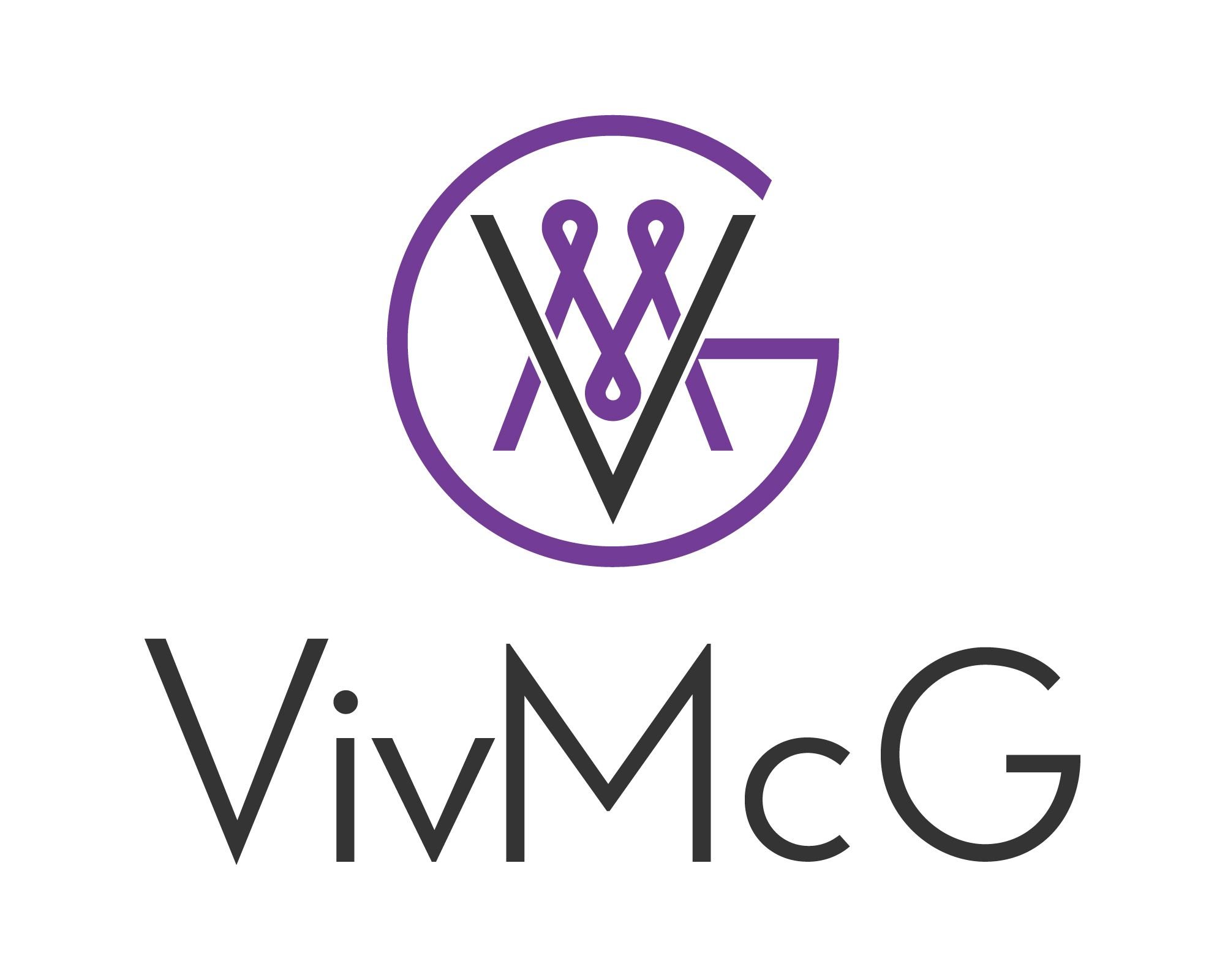start monday with gratitude
week 12
Welcome to Week 12, lovely soul.
Below you'll find the video and video transcript introducing you to this week's quote and musings.
Scroll further and you'll discover this week's daily exercises, high vibe tune, and downloadable wallpapers.
video transcript
Have you ever heard the phrase: “moving the goalposts”? It’s a phrase that’s derived from goal-based sports wherein the criterion (or goal) is changed while play is still in progress. It’s done in such a way that one side enjoys an advantage while the other is faced with a disadvantage.
When we set our own goals and choose to, consciously or unconsciously, move the goalposts, it means that every time we get close to achieving our goal, we move the goalposts that little bit further away so our ‘final’ goal remains (and always will remain) just out of reach.
Whllst some might say that constantly moving the goalposts, so your end target remains out of reach, is a way to encourage you to continually grow and move forward, it actually means that you’re future-focused rather than focused on the present moment.
When we only look to the future, when we live and strive only towards the future, we can never enjoy the feeling of achievement, accomplishment or satisfaction because we’re always pushing ourselves forward.
Such feelings can only be experienced in the present moment.
If we’re past-focused and look back and see our achievements, we can only give ourselves recognition for them. The emotion of accomplishment and achievement can never be as strong as it would have been had we experienced it at the time of the achievement. Likewise, if we’re future-focused, any achievements we accomplish along the way will never register on our radar, they’ll simply float by unnoticed without the ability to enjoy them when they happen.
It’s only when we live in and focus on the present moment, grateful for what we already have, what we are already achieving, what we are already accomplishing that we can enjoy and give thanks to achievements that are yet to come, when they arrive in the present moment.
Future achievements and goals are moving ever closer until they become our present reality, in the same way that time is always moving closer to become our present reality; tomorrow, today’s tomorrow will become today.
So, if we cannot enjoy and celebrate our goals, our achievements, our accomplishments in our present reality, then we won’t be able to enjoy and celebrate our goals, achievements, our accomplishments, yet to come, when they arrive.
daily gratitude practice
monday
Most people move the goalposts when it comes to reaching a goal.
For many it acts as a kind of self-protection mechanism because they struggle to finish any project no matter how trivial it may be and, so, moving the goalposts means they never reach the final goal.
Why would they do this?
Often, it’s a trait of those who always strive to achieve perfection. As perfection is simply unattainable, by removing the opportunity to reach the final goal removes the need to face up to being imperfect.
It’s important to understand why you move the goalposts, either in the past or continue to do so in the present.
Only by understanding why you do this, addressing the reason and finding a solution to work with, can you ever work towards non-moving and achievable goals.
Only by understanding why you do this, can you move into the present moment, celebrate and express gratitude for where you stand today in relation to your goal, because only when your goal stays standing in one place, not constantly moving, can you see where you stand currently in relation to it.
Take some time today to look back to a project where you constantly moved the goalposts. Perhaps you’re going through it at the moment with something current.
Then look inwards and ask yourself, honestly and without judgement, “why am I doing this?”
When you discover your why, think up solutions as to how you can address your why and resolve this issue. When you’ve done all this express gratitude for your courage in facing this challenge in your life and finding a resolution.
tuesday
Think back to a project in the past where you kept moving the goalposts, no matter how small or large those changes in your goals were.
How did it feel to be constantly chasing a new goalpost?
The first few times you moved the goalpost it may have felt like a relief because, in some way, you were protecting yourself, but after a while did you not start to feel frustrated, weary and exhausted because you simply weren’t reaching your final goal?
And if, at some point you decided ‘enough is enough’ and made one final change to your goal, did you actually feel excited at finally reaching your goal or was it a bit of an anti-climax because you only reached your final goal because you were simply exhausted and fed up constantly changing and chasing it?
When you finally reached your goal, were you able to celebrate and express gratitude for reaching that goal?
wednesday
Think back to a project or an event in the past where there was one set goal that simply could not be changed.
It could have been a project in work where your manager set the goal and it couldn’t be changed. Or, if you can’t think of a project, think of a running event you took part in on sports day at school, where the goal was to cross the line which marked the end of the race.
Think of a project or event with a definite goal and which didn’t take too long to reach that goal.
How did you feel to reach that end goal? How did it feel crossing that line? What kind of emotions did you experience? Were they high or low? Were they more closely associate with joy and gratitude or frustration and exhaustion? How did you celebrate? Even if you just threw your arms up in the air in celebration, you still celebrated.
Compare how you felt in this instance with how you felt in the example from yesterday where you constantly moved the goalpost.
Which emotion and feeling did you enjoy the most? Today’s, right?
thursday
Do you have a project that is running at the moment which isn’t due to finish for quite some time, say in a few years? Or a long-term project that’s about to start?
It could be an important work project or it might be a personal project. For example, you might have decided to save up so you can change your car in a couple of years without taking out a loan.
How do you tend to feel at the very start of such a project? You might feel a little apprehensive, but you should mostly feel excited and enthusiastic at the thought of achieving the desired end result.
Then as you progress further towards your goal, how do you feel? Let’s say you’re 6 months into a 3-year project. Is your excitement and enthusiasm still at the same level as when you first started or have they waned a little and you’re now just plodding along, doing what needs to be done, not enjoying the experience as much as you could and should?
Then 1 year into the project, 2 years into the project… how do you think you’ll feel? Perhaps you might have abandoned the project all together, fallen off the bandwagon and not had the enthusiasm to jump back on.
Getting close to the final goal, how will you feel? Well, if you’ve kept taking one step at a time and you’re still on track, against all the odds, of achieving the goal, you might start to feel excited again. But if you dipped in the middle of the project and lost your enthusiasm, as so often happens, you may be feeling anxious – you have so much left to achieve in so little time.
When you have a long-term project ahead of you and you only focus on the end result, is it possible to be in the present moment, to celebrate in the present moment, to express gratitude for what you have achieved up until now? It’s not.
And as a result, you may be forced to move the final goalpost so you can achieve your goal or you may need to face failure or even accept a lesser and undesirable result.
Is this the type of project that supports an attitude to gratitude? It’s not, is it.
Then what can you do? We’ll look at that tomorrow.
friday
Can you imagine how life would feel with an endless stream of short-term wins, like running a race and crossing that finish line on a regular basis? Just like in the example you chose in Wednesday’s exercise where you focused on a short-term project which you quickly and easily completed because the goalpost wasn’t moved?
Every single goal we set ourselves can be broken down into smaller steps with each individual step leading to achieving a minor goal.
Take the example you used in yesterday’s exercise, the example of a current long-term goal, either in work or personal.
Now break that goal into small steps, creating a goal for each individual step. The steps don’t need to be equal in length or size, but make sure they aren’t too few and far between.
You want to break your long-term goal into multiple steps because you want to try to keep yourself as much in the present moment as possible so you can maintain an attitude to gratitude and celebrate and express gratitude on a regular and frequent basis as you work through your project from beginning to end.
When you look at the steps and individual goals, how do you feel? Do you feel excited and enthusiastic? If you do, then the steps are right for you. If you’re still not feeling excitement and enthusiasm about this long-term project, then I invite you to break down the steps a little further so you have more mini goals and achievements to celebrate.
Only when you feel a sense of excitement and enthusiasm about your long-term project, is it broken down enough into individual steps with their own goals that you can celebrate and express gratitude for.
Can you see the difference between how you feel about this long-term project and how you expect to feel about it while you achieve each mini goal, one after the other, compared with how you felt yesterday when you started a long-term goal, never celebrated and never expressed gratitude for your journey?
Can you see how breaking down a project into smaller goals can keep your vibration high, can keep you better on track to achieving your goal, can reduce the need to change the end goal, and can keep you motivated?
You can apply this to absolutely anything and everything in your life. The more you can create mini goals to celebrate and be grateful, the more you’ll nurture an attitude to gratitude.
saturday
Think back to a goal you achieved and celebrated in the past.
It could have been a goal connected to a long-term or short-term project. It doesn’t matter. The important thing was that you celebrated reaching that goal.
How did it feel when you celebrated reaching that goal? Did it feel good accomplishing your goal?
Now look back to the project connected to that goal.
Did you break that goal down into smaller parts, into smaller achievements and did you celebrate reaching each and every one of those smaller goals? I’m suspecting the answer is ‘no’. Because when we start a project, big or small, our focus is on the end result, the final goal.
I want you to take that project and work through everything it entailed.
Break it down into smaller steps with a mini goal at the end of each step.
When you look at it this way, how many goals would you have celebrated along the way? And if you had celebrated mini goals along the way, how much more would you have enjoyed the celebration of the end goal?
There is a phrase which was first quoted by the Greek Philosopher, Aristotle, and that phrase states, “the whole is greater than the sum of its parts” which means that the whole is better than you would expect by adding the individual parts because the whole brings added quality.
When it comes to projects, it may be controversial, but I disagree with our Greek Philosopher. If you begin a project and only focus on the whole, the end goal, yes you’ll gain a sense of accomplishment and achievement which you can celebrate and express gratitude for, however you will have missed out on just how much it took to reach that goal.
Whereas, if you break the final goal down and celebrate and express gratitude each time you achieve each part, the smaller individual steps and mini goals along the way, then your sense of accomplishment and achievement will be greater and your vibrational energy will have remained high throughout the project.
So, sometimes, the whole is not greater than the sum of the parts if you fail to recognise and celebrate the importance and role the individual parts play.
Can you see how much better, how much more achievable a goal is when you break it down?
And can you also see how much easier it is to maintain a higher vibration, more attuned to gratitude, when you do this?
sunday
Look back to a past achievement, a goal that you reached and celebrated.
As we’ve already discovered, if you celebrated achieving that goal, you most likely only celebrated achieving the end goal and not the many mini steps and goals that happened in between because, most likely, you didn’t break the project down into a number of achievable parts.
Looking back now and breaking that project down into the many mini steps and goals, I invite you to celebrate achieving them one by one.
How does it feel to celebrate those smaller achievements long after you did? Does the emotion and feeling of excitement feel as strong as it would have, had you celebrated achieving those smaller goals as they arose?
The emotion of accomplishment and achievement can never be as strong as it would have been had we experienced it at the time of the achievement.
Now that you know the benefit of breaking a project down into mini steps and goals so you can celebrate, express gratitude and keep a high vibe throughout the whole project, can you also see the difference in celebrating a mini goal when it comes along, in the present moment, compared to celebrating it when it’s long since passed?
Again, this highlights the importance of being in the present moment and expressing gratitude in the present moment.
When we’re in the present moment and celebrate in the present moment, it also ensures we do not miss out on expressing gratitude and celebrating mini goals as they arise, thus keeping our energy and vibe high.
and let's not forget...
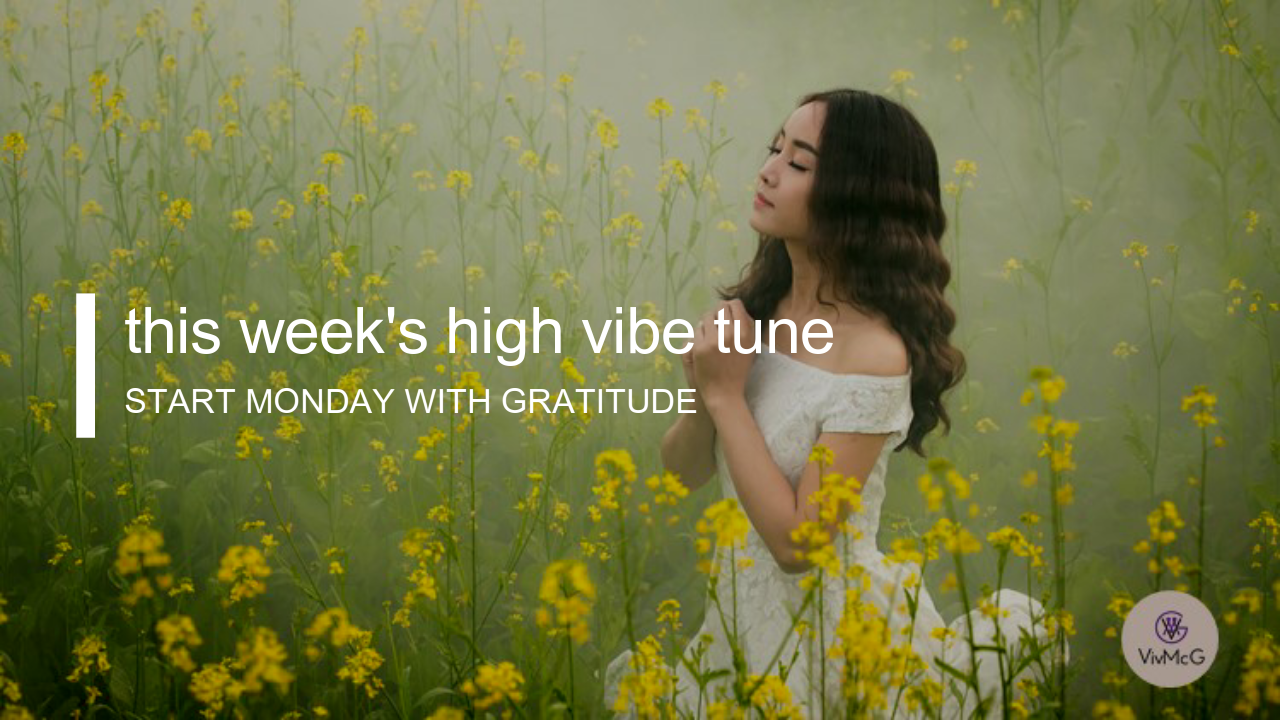
This week's high vibe tune reminds us that when you have gratitude, you have it all
have gratitude wherever you go...
... with this week's gratitude quote wallpaper.
Note: details of how to download this week's wallpaper is provided below.
“Be grateful for what you already have while you pursue your goals. If you aren’t grateful for what you already have, what makes you think you’d be happy with more” ~ Roy T Bennett
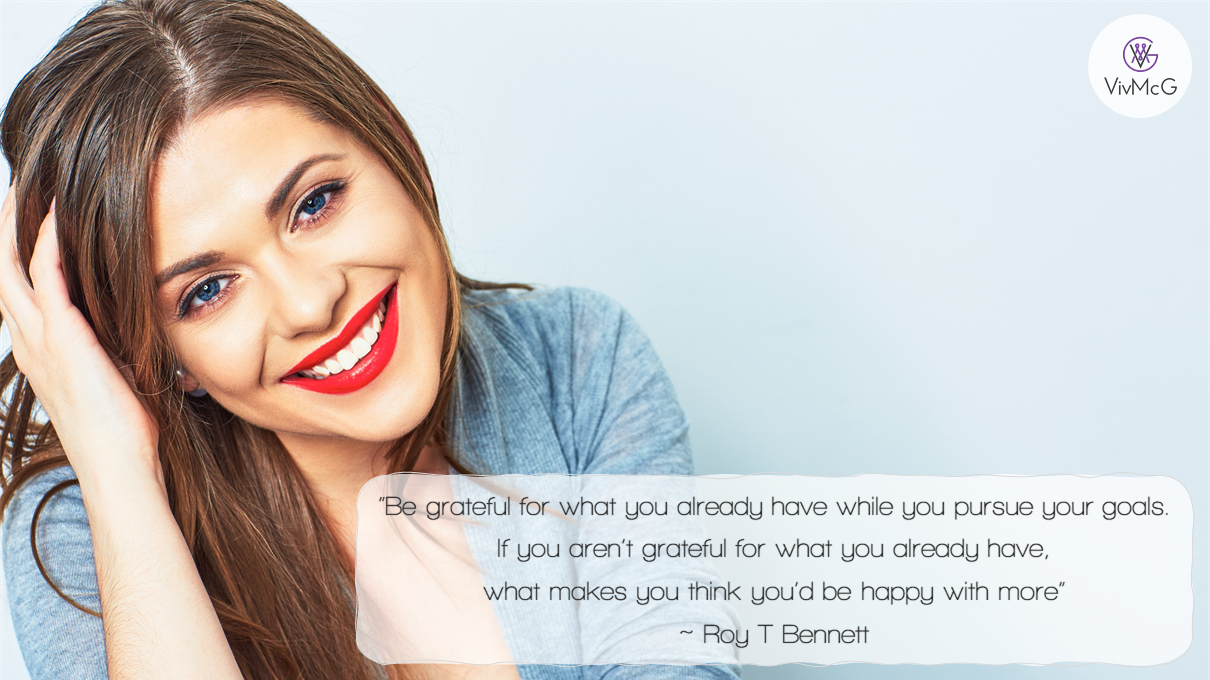
16:9
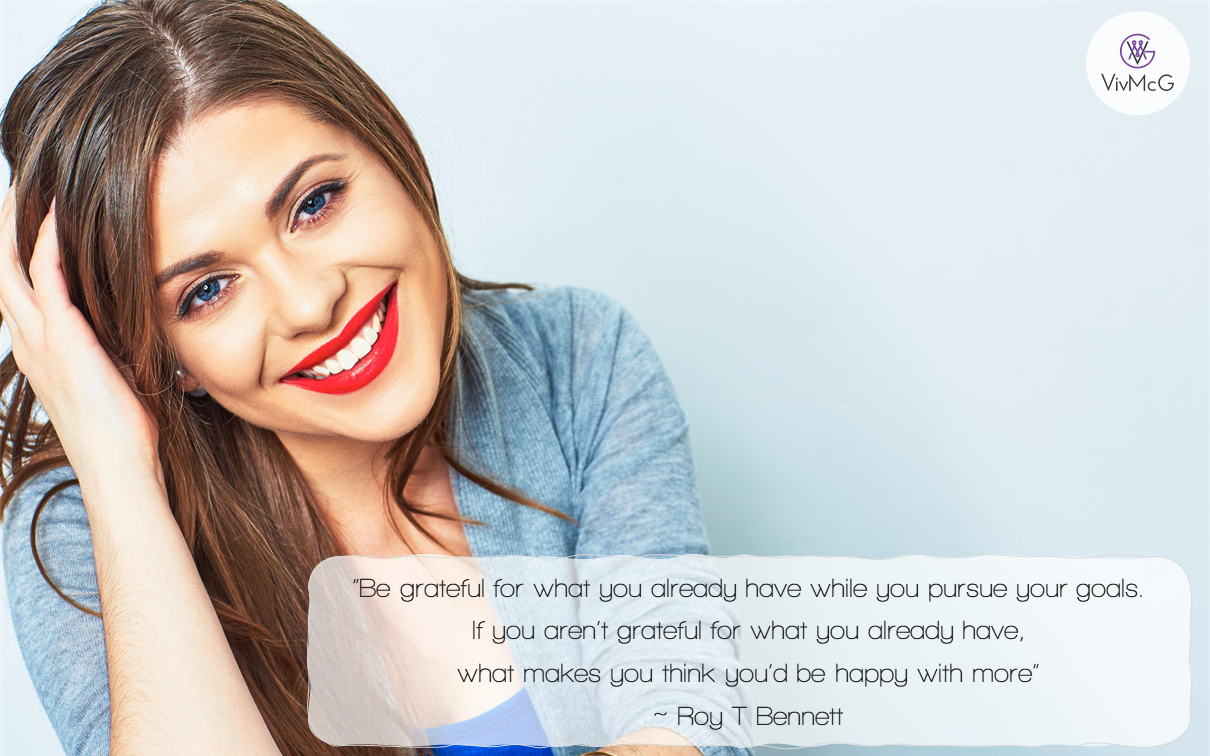
16:10
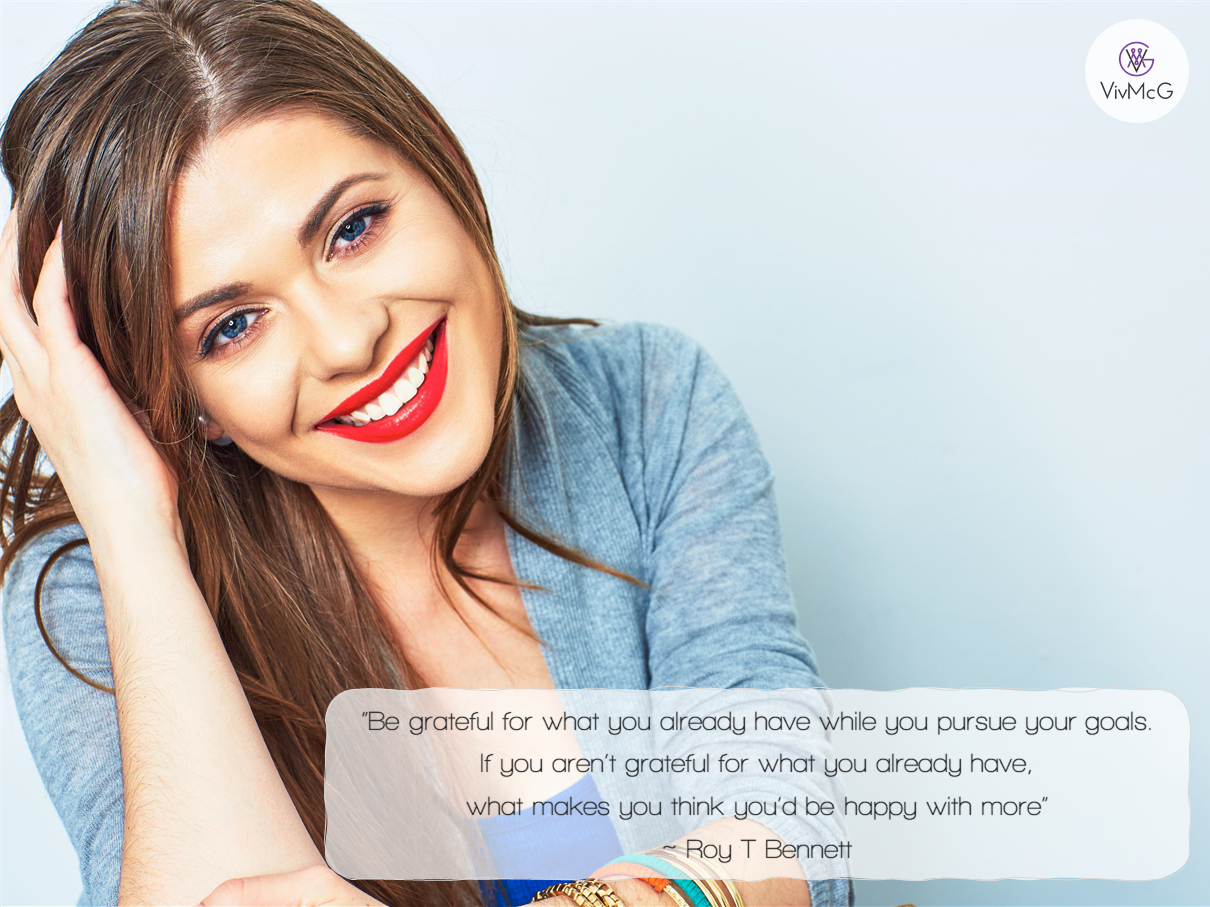
4:3

mobile
how to download your wallpaper
desktop
Before copying one of the pictures below, you'll want to quickly check your screen settings because the worst thing you can do is use a wallpaper with an aspect ratio that differs from the aspect ratio of your screen.
The aspect ratio of a rectangle is simply the proportion between width and height. The most common are 16:9, 16:10 and 4:3. And it will be for these 3 sizes that I shall provide you with your free wallpaper.
To find your screen resolution follow this basic guide. Steps for your computer may vary slightly but I hope this will give you some guidance:
- Right-click the desktop and select Display settings.
- Scroll down until you see "Resolution" (you may have to choose an "Advanced" option)
- To find your aspect ratio, divide the width over the height. For example, if my resolution is 1920 x 1080 then I would divide 1920 over 1080 to get 1.778, which indicates a 16:9 resolution. Similarly, 1.6 indicated 16:10 and 1.333 indicates 4:3
- When you've calculated your screen's aspect ratio, go to the picture below that matches that size
- Right click on the picture and select "Set as Desktop Background"
- Choose whether to "Fill", "Fit", or "Stretch" your picture - if you've chosen the right size "Fit" will be your best option
- Select "Set Desktop Background" and you're done
android mobile
- First, save the wallpaper image to your phone by pressing your finger on the wallpaper image and hold down on it until you see a menu.
- From here, click the “Save image” tab, and it will begin downloading.
- The next step is to set this saved image as your wallpaper by pressing and holding a blank area on your screen (meaning where no apps are placed), and home screen options will appear.
- Select 'add wallpaper' and choose whether the wallpaper is intended for 'Home screen', 'Lock screen', or 'Home and lock screen'.
- Another set of options will appear where you can choose where the photo you would like to use will be coming from, namely the Gallery.
- If necessary, crop the image to a suitable size. Once satisfied, simply click 'Done'.
ios smartphone
- First, save the wallpaper image to your phone by pressing your finger on the wallpaper image and hold down for about 2 seconds until a menu appears.
- From here, click “Save Image“, and it will begin downloading.
- The next step is to set this saved image as your wallpaper by, first, going to the 'Photos' app and selecting the wallpaper photo you've saved there.
- Click on the share icon on the lower left corner of the screen, then select 'Use as Wallpaper'.
- Then choose to set the photo as either the lock screen, home screen or both.

